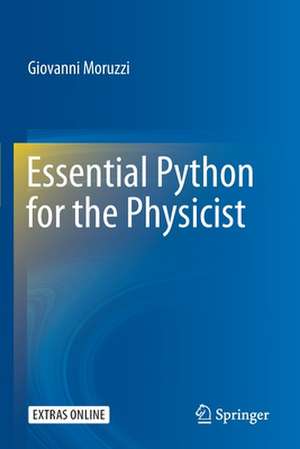Essential Python for the Physicist
Autor Giovanni Moruzzien Limba Engleză Paperback – 3 iun 2021
| Toate formatele și edițiile | Preț | Express |
|---|---|---|
| Paperback (1) | 490.40 lei 6-8 săpt. | |
| Springer International Publishing – 3 iun 2021 | 490.40 lei 6-8 săpt. | |
| Hardback (1) | 591.79 lei 6-8 săpt. | |
| Springer International Publishing – 3 iun 2020 | 591.79 lei 6-8 săpt. |
Preț: 490.40 lei
Nou
Puncte Express: 736
Preț estimativ în valută:
93.87€ • 101.100$ • 78.90£
93.87€ • 101.100$ • 78.90£
Carte tipărită la comandă
Livrare economică 21 aprilie-05 mai
Preluare comenzi: 021 569.72.76
Specificații
ISBN-13: 9783030450298
ISBN-10: 3030450295
Pagini: 302
Ilustrații: X, 302 p. 111 illus., 62 illus. in color.
Dimensiuni: 155 x 235 mm
Greutate: 0.48 kg
Ediția:1st ed. 2020
Editura: Springer International Publishing
Colecția Springer
Locul publicării:Cham, Switzerland
ISBN-10: 3030450295
Pagini: 302
Ilustrații: X, 302 p. 111 illus., 62 illus. in color.
Dimensiuni: 155 x 235 mm
Greutate: 0.48 kg
Ediția:1st ed. 2020
Editura: Springer International Publishing
Colecția Springer
Locul publicării:Cham, Switzerland
Cuprins
Preface.- 1 Python Basics and the Interactive Mode.- 2 Python Scripts.- 3 Plotting with Matplotlib.- 4 Numerical Solution of Equations.- Numerical Solution of Ordinary Dierential Equations (ODE).- 6 Tkinter Graphics.- 7 Tkinter Animation.- 8. Classes.- 9 Appendix.
Notă biografică
Giovanni Moruzzi is a retired associated professor from the Physics Department of the University of Pisa, where he is still teaching classical electromagnetism and basic computer algorithms.
His research interests cover atomic and molecular spectroscopy, in particular the assignment of dense molecular spectra involving internal large-amplitude motions. He has published more than 70 papers on peer-reviewed journals and has been co-editor and coauthor of two scientific books.
His research interests cover atomic and molecular spectroscopy, in particular the assignment of dense molecular spectra involving internal large-amplitude motions. He has published more than 70 papers on peer-reviewed journals and has been co-editor and coauthor of two scientific books.
Textul de pe ultima copertă
This book introduces the reader with little or no previous computer-programming experience to the Python programming language of interest for a physicist or a natural-sciences student. The book starts with basic interactive Python in order to acquire an introductory familiarity with the language, than tackle Python scripts (programs) of increasing complexity, that the reader is invited to run on her/his computer. All program listings are discussed in detail, and the reader is invited to experiment on what happens if some code lines are modified. The reader is introduced to Matplotlib graphics for the generation of figures representing data and function plots and, for instance, field lines. Animated function plots are also considered. A chapter is dedicated to the numerical solution of algebraic and transcendental equations, the basic mathematical principles are discussed and the available Python tools for the solution are presented. A further chapter is dedicated to the numericalsolution of ordinary differential equations. This is of vital importance for the physicist, since differential equations are at the base of both classical physics (Newton’s equations) and quantum mechanics (Schroedinger’s equation). The shooting method for the numerical solution of ordinary differential equations with boundary conditions at two boundaries is also presented. Python programs for the solution of two quantum-mechanics problems are discussed as examples. Two chapters are dedicated to Tkinter graphics, which gives the user more freedom than Matplotlib, and to Tkinter animation. Programs displaying the animation of physical problems involving the solution of ordinary differential equations (for which in most cases there is no algebraic solution) in real time are presented and discussed. Finally, 3D animation is presented with Vpython.
Caracteristici
Introduces the natural-science student to the Python programming language Codes of all programs discussed in this book are available at Springer.com No previous experience with other programming languages is required Focuses on simple computer animation programs of physical interest
